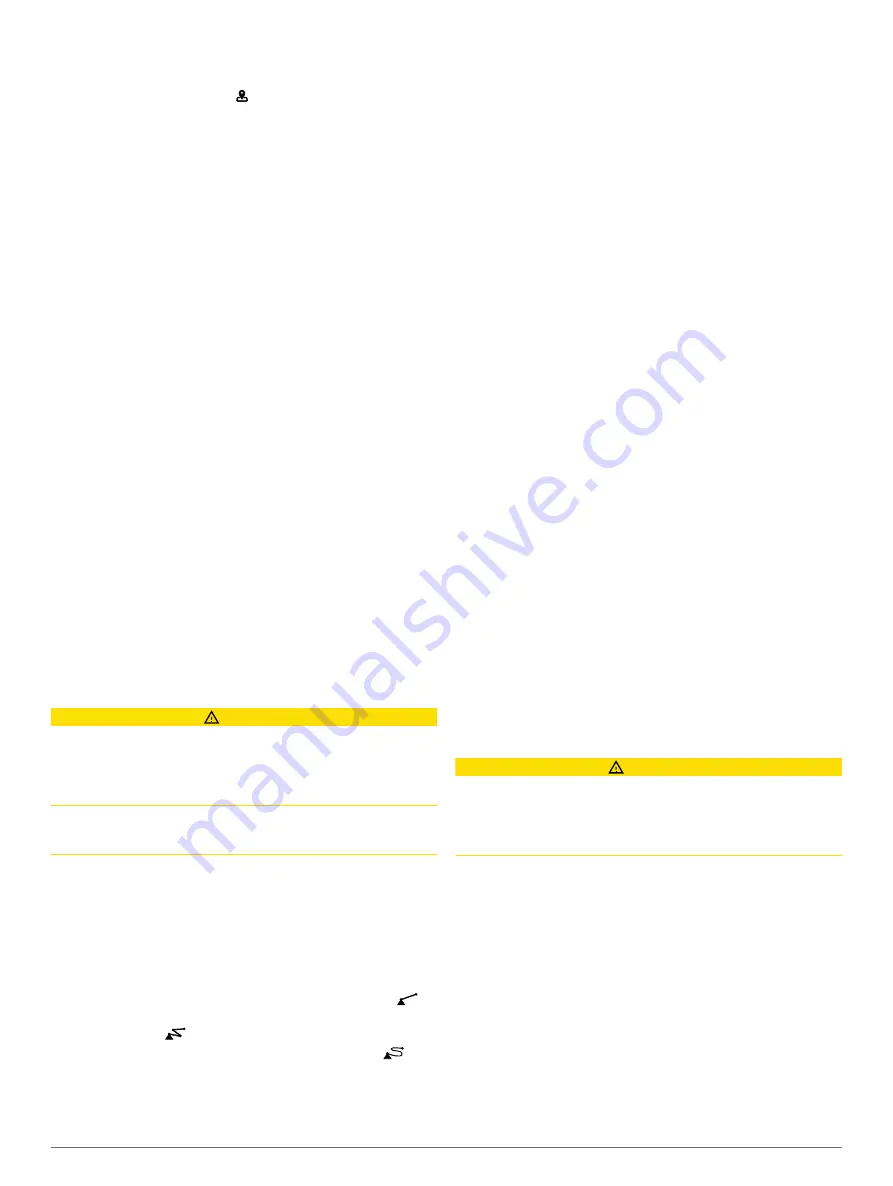
Creating a Waypoint on the Chart
1
From a chart or a 3D chart view, select a location or object.
2
Select
Create Waypoint
or .
Viewing Location and Object Information on a Chart
You can view information about a location or an object on the
Navigation chart or the Fishing chart.
NOTE:
The offshore Fishing chart is available with premium
charts, in some areas.
1
From the Navigation chart or Fishing chart, select a location
or object.
A list of options appears along the right side of the chart. The
options that appear vary based on the location or object you
selected.
2
Select an option:
• To navigate to the selected location, select
Navigate To
.
• To mark a waypoint at the cursor location, select
Create
Waypoint
.
• To view the distance and bearing of the object from your
current location, select
Measure Distance
.
The distance and bearing appear on the screen. Select
Select
to measure from a location other than your current
location.
• To view tide, current, celestial, chart notes, or local
services information near the cursor, select
Information
.
Viewing Details about Navaids
From the Navigation chart, Fishing chart, Perspective 3D chart
view, or Mariner’s Eye 3D chart view, you can view details about
various types of navigation aids, including beacons, lights, and
obstructions.
NOTE:
The offshore Fishing chart is available with premium
charts, in some areas.
NOTE:
Mariner's Eye 3D and Fish Eye 3D chart views are
available with premium charts, in some areas.
1
From a chart or 3D chart view, select a navaid.
2
Select the name of the navaid.
Navigating to a Point on the Chart
CAUTION
The Auto Guidance feature is based on electronic chart
information. That data does not ensure obstacle and bottom
clearance. Carefully compare the course to all visual sightings,
and avoid any land, shallow water, or other obstacles that may
be in your path.
When using Go To, a direct course and a corrected course may
pass over land or shallow water. Use visual sightings, and steer
to avoid land, shallow water, and other dangerous objects.
NOTE:
The offshore Fishing chart is available with premium
charts, in some areas.
NOTE:
Auto Guidance is available with premium charts, in some
areas.
1
From the Navigation chart or Fishing chart, select a location.
2
If necessary, select
Navigate To
.
3
Select an option:
• To navigate directly to the location, select
Go To
or
.
• To create a route to the location, including turns, select
Route To
or
.
• To use Auto Guidance, select
Auto Guidance
or
.
4
Review the course indicated by the magenta line.
NOTE:
When using Auto Guidance, a gray segment within
any part of the magenta line indicates that Auto Guidance
cannot calculate part of the Auto Guidance line. This is due to
the settings for minimum safe water depth and minimum safe
obstacle height.
5
Follow the magenta line, steering to avoid land, shallow
water, and other obstacles.
Heading Line and Angle Markers
The heading line is an extension drawn on the map from the
bow of the boat in the direction of travel. Angle markers indicate
relative position from the heading or course over ground, which
are helpful for casting or finding reference points.
Setting the Heading and Course Over Ground Lines
You can show the heading line and the course over ground
(COG) line on the chart.
COG is your direction of movement. Heading is the direction the
bow of the boat is pointed, when a heading sensor is connected.
1
From a chart view, select
Menu
>
Chart Setup
>
Chart
Appearance
>
Heading Line
.
2
If necessary, select
Source
, and select an option:
• To automatically use the source available, select
Auto
.
• To use the GPS antenna heading for COG, select
GPS
Heading (COG)
.
• To use data from a connected heading sensor, select
North Reference
.
• To use data from both a connected heading sensor and
the GPS antenna, select
COG and Heading
.
This displays both the heading line and the COG line on
the chart.
3
Select
Display
, and select an option:
• Select
Distance
>
Distance
, and enter the length of the
line shown on the chart.
• Select
Time
>
Time
, and enter the time used to calculate
the distance your boat will travel in the specified time at
your present speed.
Turning on Angle Markers
You can add angle markers to the map along the heading line.
Angle markers can be helpful for casting when fishing.
1
Set the heading line (
Setting the Heading and Course Over
).
2
Select
Angle Markers
.
Premium Charts
CAUTION
The Auto Guidance feature is based on electronic chart
information. That data does not ensure obstacle and bottom
clearance. Carefully compare the course to all visual sightings,
and avoid any land, shallow water, or other obstacles that may
be in your path.
NOTE:
Not all models support all charts.
Optional premium charts, such as BlueChart g2 Vision
®
, allow
you to get the most out of your chartplotter. In addition to
detailed marine charting, premium charts may contain these
features, which are available in some areas.
Mariner’s Eye 3D
: Provides a view from above and behind the
boat for a three-dimensional navigation aid.
Fish Eye 3D
: Provides an underwater, three-dimensional view
that visually represents the sea floor according to the
information on the chart.
Fishing Charts
: Shows the chart with enhanced bottom
contours and without navigational data. This chart works well
for offshore deep-sea fishing.
High Resolution Satellite Imagery
: Provides high-resolution
satellite images for a realistic view of the land and water on
Charts and 3D Chart Views
5
Содержание GPSMAP 7600 Series
Страница 1: ...GPSMAP 7400 7600 Series Owner s Manual June 2016 190 01841 00_0E...
Страница 8: ......




























